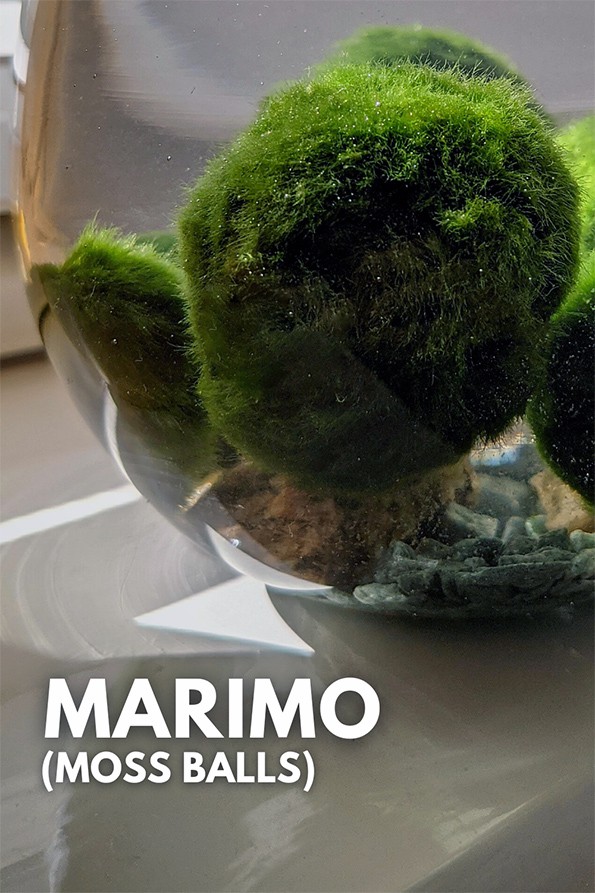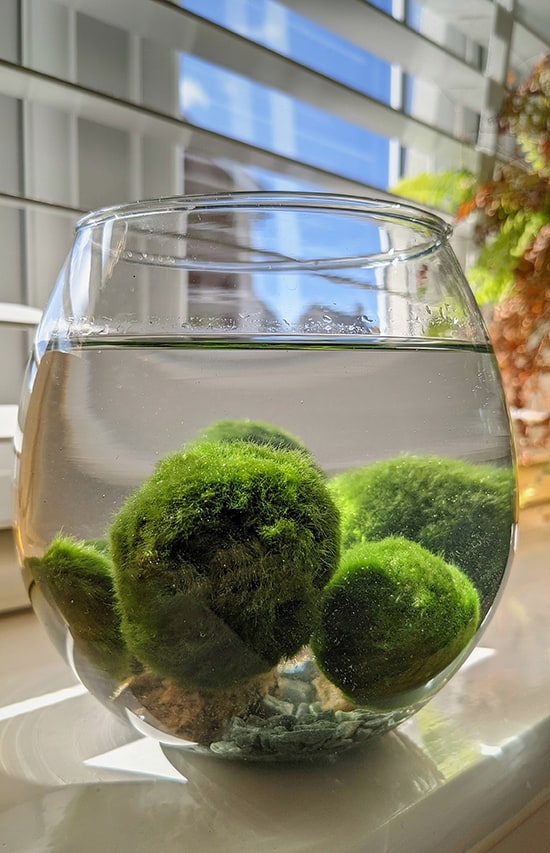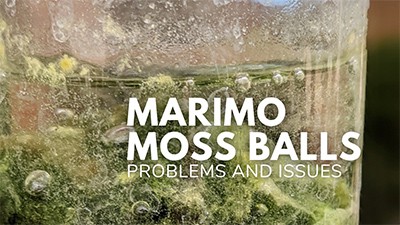Moss Balls, or "Marimo" weren't traditionally grown as houseplants and it's not made of moss (it's actually an Algae called Aegagropila linnaei). But they make great indoor plants.
All they really need is to be immersed in room temperature water, changing it every few weeks and kept out of direct sunlight. In return, you get a round ball of velvety greenery that provides a talking point and a touch of calming aquatic life.
Obviously, there is a little more to the care than this, so along with some helpful tips and tricks to get the most of your Marimo and by the end of this article, you'll know it all.
Marimo Moss Balls can easily be grown individually or in small groups. Many consider them good luck charms or even family heirlooms due to how long they can live.
These slow-growing aquatic plants are often placed in fish tanks as they can help keep the water clean, provide some enrichment to the fish, and add to the aesthetic of a tank.
However, they will live just as well (probably better, in fact), by growing them by themselves in see-through vessels, vases or jars.
How do you pronounce Marimo correctly? Say:
Mar-ee-moh
Aegagropila linnaei is native to lakes and rivers in Japan and Northern Europe, with larger colonies growing in cold water areas with fairly low biological activity and in the wild, can easily live to be over 100 years old.
Did you know?
The Latin name for these plants is Aegagropila linnaei, but I've also seen them labeled in stores as "Cladophora linnaei" or " Cladophora ball". However, they're the same plant.
The water currents gradually move and turn the balls over and over which creates the round shape and familiar look. When grown in standing water at home, they will lose this shape, but I'll cover this later and explain how you can fix it.
Unfortunately, their numbers in the wild are in decline, and they've become a protected species in many parts of the world. So if you want them, you'll have to buy them rather than harvesting them yourself.
Some pointers about buying Marimo can be found at the end of this article. First, though, the care tips and growing guide.

Hi, I'm Tom!
If you're like me and enjoy the challenge of growing houseplants and getting them to thrive, then Ourhouseplants can help. This website shares my knowledge and years of growing plants and provides (hopefully) helpful advice on properly caring for your indoor plant friends.
In their natural habitat, Marimo often grow at the bottom of lakes and rivers. Usually, these are relatively shallow, but the amount of light reaching them, compared with "usual" houseplants, falls between low light to medium light levels.
This means they can do very well in many lower light spots in your home. I have a lot of them growing in glass containers and they're easy to dot around in awkward places that don't get much light.
Did you know?
In Japanese, "Marimo" translates to "Ball Algae" although some think it means "Seaweed Ball". In any case, Moss Balls aren't seaweed at all. They're a species of filamentous green algae (A. linnaei).
You do need to avoid any window ledges or places where a high amount of sun falls onto them (or the glass of their containers), too much bright light or full sun will cause the balls to turn brown.
As an example, in the northern hemisphere, a North Facing windowsill would be a great pick. Good light, no sun at all and typically a cooler aspect than others.
For me, "enough light", is when I can see a few air bubbles on the outside of a Marimo ball during the daytime. If there are too many of these little bubbles to count then it's a potential sign they're getting too much indirect sunlight.
Caring for Moss Balls is easy and once you have a good place for them to live they're low low maintenance houseplants.
What type of water do Moss Balls need?
Some people recommend using pure and filtered water only. If you want to do this, then it's probably fine to do. But personally, I've just used regular tap water for years without any problems.
This is an aquatic plant, so it needs to be submerged in water pretty much always. They can cope with short periods of time out of water, but must not be allowed to dry out fully.
In the past, I've had some posted to me in sealed plastic bags. They've arrived "damp" and been perfectly fine, despite being outside of water for days during transit. So as long as you can keep the surrounding air moist, they will be okay for a few days. But again, they're aquatic plants and can't be kept like this indefinitely.
It's almost certain you'll be growing them in a glass or see through container of some kind (or how else are you going to see them!). The container could be sealed or open, but in both cases, you'll need to change the water every few weeks.
As touched on earlier some people use them as aquarium plants to help fill a freshwater aquarium fish tank. Their care needs are similar, but primarily with my care instructions, I'm approaching things from a "houseplant" perspective, so if you have "tank mates" to consider AKA live fish, it might be worth checking out an Aquarium expert for further tips.
Theoretically, they need 100% humidity, but once they've been submerged they'll get this, so it's not something you need to worry about.
In some of their native habitats, Marimo Moss Balls have become endangered, and some countries treat them as a protected plant species. Research shows this is happening because lakes are becoming more fertile and the increasing amount of nutrients are damaging their populations.
You may not believe me, but in all the years of ownership, I've fed mine maybe, twice. That's it.
They make a fantastic gift for almost anyone.
It's a very unusual and quirky plant, but still super easy to care for, so they can make brilliant birthday presents.
Your child might keep asking for a pet... What about getting them a few "Moss Ball Pets" instead? Much better than a "Pet Rock" and cheaper than a real animal!
My personal recommendation is not to worry about feeding your Marimo too much.
But if you want to, then you can put a single drop of liquid houseplant feed a few times a year into the water when you change it.
Change the water again a few days later. This will give your Marimo a chance to absorb some nutrients during this period but at the same time, not overdo it.
If you'd like to see some my plants in video format check out my YouTube care guide.
This is a plant that's well adapted to cool and cold water temperatures. In fact, it needs this to thrive. Avoid anything close to freezing temperatures, but equally, be careful about hot locations in your home too.
The water it's growing in will eventually reach a similar temperature to the room they're in. Fish owners have reported problems with their Marimo, such as brown spots when placed in warm tropical fish tanks. So avoid heat where possible.
Any room in your home that gets close to 24°C (75°F) regularly, is likely approaching a warning level and will be too hot.
These Marimo Balls are growing next to a window with direct sunlight hitting the fish bowl. OK for a photo, but do not position them long term in spots where this can happen. The sun will heat up the water temperature quickly and could damage your plants.
Marimo doesn't grow in soil, so there is no need to "repot" them. But you should:
I use standard tap water with no problems. You can also use other types of water, like filtered, rain, aquarium water or occasionally even carbonated sparkling water to give it a boost.
Make sure you wash and clean your Marimo Ball.
Do in at every couple of water changes, give them a rinse in clean water and a gentle squeeze a few times to help remove any decaying material, dirt and grime. To keep it simple, you can just use tap water for this.
The carbon dioxide in sparkling water creates those familiar air bubbles, which is an easy form of carbon that the Marimo will use for photosynthesis.
Moss Balls are reasonably easy to propagate. They might look like a round ball of moss with a solid core, but they're actually very spongy and the middle is almost hollow. This means you can gently "rip" the balls in half (or into smaller bits).
So one large Marimo moss ball can create several smaller ones. A really important note before you get to work making Marimo babies is that they are slow growing plants (we're talking tortoise level here), even in ideal conditions.
This means you'll be ruining your larger Marimo to create smaller ones that will take years or even decades to grow back to that larger size.
Personally, unless my Moss Ball was "cracking" apart, I would not look to propagate; instead, I would just buy more.
Although they can easily live to well over 100 years they do not grow quickly. Even in excellent conditions, they won't grow much more than 5mm (0.2 in) each year.
They can look bigger over time if they start to come apart slightly, but once you've washed them and rolled them back into a rounded shape they'll look smaller again.
Although they're slow growing they can still get relatively large after many years (or if you just buy huge ones to start with!). In nature they can regularly reach up to 12 inches (30cm) or more, but indoor plants will realistically only reach a fraction of that size.
If you have any super large ones in your collection, I'd love to see them! Share them in the comments below or drop me an email.
Two of my Moss Balls. The one on the left is almost 6 inches (15cm) in circumference and the one on the right is 2 inches (5cm).
Algae doesn't produce flowers or blooms in the traditional way, so you won't get any flowers on your plants.
The plants themselves are harmless, but the water they're living in could be dirty and harm your pets. That aside, it would be a real shame if you let your cat or dog play with your Marimo as they can easily be damaged (or even eaten because they look like a bouncy ball toy!).
Moss Balls will lose their shape overtime when grown indoors. The spherical shape is created and maintained by the constant movement of water currents, which do not exist in glass jars or bottles. They also need a good wash every now and again to keep them clean.
This is how you fix both problems.
How should they look, feel and smell?
Healthy Marimo balls will be a darkish green and have a circular shape.
To the touch, they should feel like a slightly firm tennis ball, with some give when squeezed that "push" back out when you let go.
Most people think an "algae ball" will have a seaweed type of smell. But most of mine (when out of the water) have a slight mossy, earthy or even a "freshly cut grass" smell.
If your Marimo doesn't have these qualities, it could have a possible problem that needs fixing.
Every few weeks when you do a water change you should think about giving your plants a wash. To do this gently and evenly squeeze out the water, then rinse again. Do this a few times until the water being squeezed out becomes clear.
To get them back to a rounded shape, in their rinsed-out state, put it on the palm of your hand. Then put your other hand on top so you're gently cupping it. Roll your hands gently for 30 seconds as if you're rolling plasticine or making something like chocolate truffles.
Your Marimo should look a lot better and be more rounded. You can then just pop them back into their home and they should pretty much hold the spherical shape you've just rolled them into.
Freshly washed plants can sometimes "float" for a day or two because you've introduced air bubbles into the center of the balls. This is perfectly fine and not a problem. They should sink again in time.
Use the slider above to tap / swipe back and forth to see the difference a little rolling in your hands can do for your plants from time to time.
Maybe you've got one already, and you want more of the fluffy cuteness. Well, I don't blame you! Here are my tips when shopping for more (or replacements!).
Zebra mussels issue in the United States.
The US currently has an ongoing problem with Zebra Mussels that may impact being able to buy Marimo plants.
Zebra Mussels are an invasive species and were found growing in some Moss Balls in early 2021.
Screening by US Authorities seems to have since calmed the problem, but the concern about them getting into waterways is still in place. If you own Moss Balls and live in the US, I recommend you check out the official guidance.
Unlike many other indoor plants available today, they're no variegated varieties or Cultivars to look out for. But the original green balls are, in my opinion, novel enough to sell themselves.
Initially popular as "houseplants" in Japan (hence why they sometimes go by the name "Japanese Moss Balls"), they've spread across the world and can be found in many places that sell houseplants, even the occasional pet store that sell fish may stock them. Availability is therefore normally good.
Due to an issue with Zebra Mussels, they may be harder to come by in the United States. But hopefully, the situation will be rectified and you'll be able to purchase them again easily soon.
It's usual to buy them in fancy looking or designer glass vases which can push up the prices. But if you already have a suitable home for them, you can get them from online sellers who will typically post them in airtight plastic bags or containers. Once they arrive, they could be dehydrated, so get them into water as soon as you can.
The Moss Balls are cute by themselves, but a collection in closed jars with wooden stoppers, a glass container or mason jars part filled with clean gravel can really look impressive.
If you follow my Marimo Moss Balls care instructions above, you will hopefully have many years of problem-free ownership. But sometimes things go wrong, and your plants need some help.
Unhealthy Moss Balls can usually be fixed. Be sure to have a look at our problem article for tips.
They're pretty resilient, so they can often recover in time. But first, you need to understand what's gone wrong and what the symptoms you're looking at mean.
Have a look at my Problem and Common Issues guide which will help you solve any issues.





